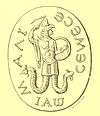Holy Book of the Great Invisible Spirit
| Part of a series on | |||
| Gnosticism | |||
|---|---|---|---|
 | |||
| History | |||
| Proto-Gnostics | |||
| Scriptures | |||
|
|||
| Lists | |||
| Related articles | |||
Two versions of the formerly lost Holy Book of the Great Invisible Spirit, also informally called the Coptic Gospel of the Egyptians[1] (which is quite distinct from the Greek Gospel of the Egyptians), were among the codices in the Nag Hammadi library, discovered in 1945. It received the name because towards the end of the text it is also expressed as the “Egyptian Gospel.” Although it is possible that it was written in Egypt, it is far more likely that the name is based on connections made between Seth of the Old Testament and Seth, the ancient Egyptian god of violence, chaos, and storms. This Gospel differs from the Gospel of Philip and the Gospel of Truth in that it is not from a Valentinian perspective and instead focuses on a viewpoint rooted in Sethianism.[2]
Overview
The main contents concern the Sethian Gnostic understanding of how the earth came into being, how Seth, in the Gnostic interpretation, is incarnated as Jesus in order to release people's souls from the evil prison that is creation. More specifically, the text can be divided into four parts concerning the creation of the heavenly world: the creation of the heavenly world, the creation and significance of the race of Seth, a hymn, and the history behind the creation of the text itself[2]
It also contains a hymn, parts of which are unusual in being apparently meaningless sequences of vowels (thought to be a representation of early Christian glossolalia), although the vowels of the final paragraph (u aei eis aei ei o ei ei os ei) can be partitioned to read (in Greek) who exists as Son for ever and ever. You are what you are, you are who you are. One explanation could be that these vowels are connected to the divine name YHWH. Another possibility is that the vowels could represent a secret, sacred way for the soul of the reader to move closer to gnosis [2]
References
- ↑ John D. Turner: "Since the late 1940s it has become customary to refer to it inappropriately as the Gospel of the Egyptians." Meyer, Marvin (2007). The Nag Hammadi Scriptures: International Edition. p. 247.
- 1 2 3 Foster, Paul (2009). The apocryphal Gospels : a very short introduction. Oxford: Oxford University Press. pp. 56–58. ISBN 978-0-19-923694-7.
External links
- Gnostic Society Library: translated text
- List of heavenly beings in the Holy Book of the Great Invisible Spirit